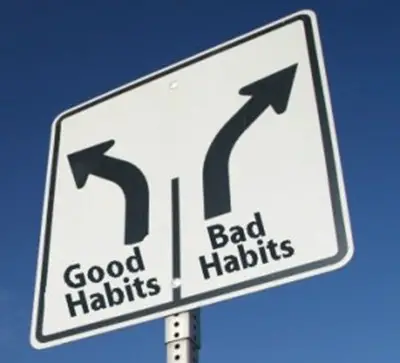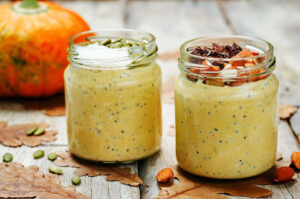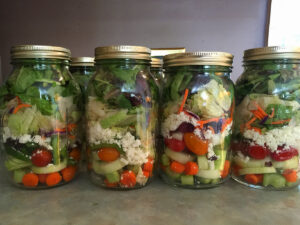The majority of New Year’s resolutions are made up of breaking bad habits and creating new good habits. In our Get Healthy Challenge, that’s what we are mainly trying to do. And it’s the hardest thing to do. Together, though, it’s easier.
Emily:
So how do you break a bad habit? Neuroscience research provides two clues:
- Habits are triggered by a particular cue, situation, or event.
- Habits are persistent—once formed, they are very hard to break.
Therefore, to break the habit:
- Learn to recognize the trigger for your bad habit.
- Wire a new healthy or positive habit to override the bad-habit trigger.
Breaking your bad habit could be achieved by carefully paying attention to what, where, when, and why your habit is triggered. Once you recognize the trigger, the trick is to consciously and mindfully repeat your new desired behavior, action, or thought instead. Similar to forming the old habit, you must repeat this process over and over until the new habit is wired to the old trigger—eventually masking the old habit.
- Reduce or eliminate all sodas and sweetened drinks. This includes diet sodas, which can cause as much weight gain as regular sodas. Drinking a sweetened drink is like main-lining sugar straight into your blood stream. Try replacing sugared drinks with sugar-free herbal tea or water. Add flavor to your water with a slice of lime or lemon, a slice of cucumber, or a few raspberries or strawberries (look for organic berries, as conventionally-grown berries top the Dirty Dozen list). If you’re drinking multiple cans of soda a day, start by drinking half as much. Eventually cut back further until you’re not drinking any soda at all.
- Reduce or eliminate refined grains. This includes refined flours and foods with white, enriched, or bleached flour. Most breads, even those labeled as “whole grain,” include refined grains. A whole grain is fully intact, such as a grain of rice or quinoa. There are varieties of bread made from whole sprouted nuts and seeds, but for the most part, breads, pastas, crackers, and cookies all contain refined grains.
- Reduce or eliminate sugar. With sugar consumption linked to conditions such as heart disease, dementia, obesity, and diabetes, it’s particularly important to cut back on sugar intake for optimal health. Sugar hides in 74 percent of processed foods, so read labels carefully.A good rule of thumb is to consume no more than 25 grams of added sugar (about six teaspoons) a day. For context, the average soda contains 40 grams of sugar—almost twice the daily recommendation. Americans now, on average, consume 1/3 cup of added sugar per day.
- Eat starchy root vegetables in moderation. Although all vegetables have beneficial nutritional properties, if you are trying to follow a moderately low-carb diet, eat starchy root vegetables (such as potatoes, sweet potatoes, and beets) no more than once or twice a week.
- Eat high-quality sources of protein. When you cut back on carbs, you’ll need other foods to help you stay satiated. It’s important to choose high-quality protein sources (not processed meats, which can also contain sugar and other carbs). Aim to eat free-range, organic, or wild-game animal protein whenever possible. Cut back on red meat and eat fish a few times a week, checking the Monterey Bay Seafood Watch website to ensure you’re eating sustainable, low-toxin fish. Beans—although high in carbs—are also high in protein and fiber, which help to slow the release of glucose into the bloodstream. Quinoa, nuts, and seeds are also good sources of non-animal complete proteins.
- Eat high quality, healthy fats. Another good way to stay satiated while cutting back on carbs is to fill up on healthy fats. These include avocados, olives, nuts, and seeds (such as chia and hemp), nut butters, and oils (such as coconut, avocado, olive, and walnut oils). Your brain needs healthy fats to function properly.
Christina: My sister is awesome at research and her findings above make a lot sense! There isn’t much more I can add to it. I’ve read what she has above and these are my thoughts and assessment of my situation:
- Learn to recognize the trigger for your bad habit. – For me, my urge to make bad eating choices happens when I’m alone. It’s like I’m being bad and as soon as Bill walks out the door, I ransack the cupboards for something scrumptious. It’s silly because he doesn’t care what I eat. Maybe it stems from childhood and wanting what you aren’t supposed to have.
- Wire a new healthy or positive habit to override the bad-habit trigger. – KNOWING this trigger now, I create a food plan for myself for when he is gone. I include something that seems “bad for me” so I fulfill that trigger. I may have healthy popcorn and sprinkle nutritional yeast (Thanks Emily for the food tip!) on it or I have an Italian ice (Lindy brand is my favorite!).
This completes our Get Healthy New Year Challenge. Thanks for being with us as we explored this health challenge. If you missed any of our posts on this, please visit our tag: Get Healthy New Year Challenge






